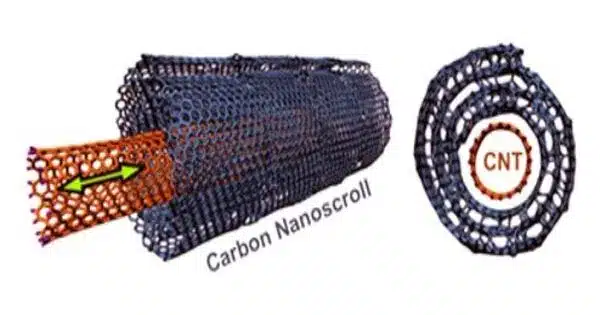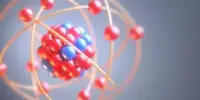Carbon nanoscrolls have a structure similar to that of a multi-walled carbon nanotube, but with a spiral-like rolled-up geometry and open edges at the ends. These are one-of-a-kind and interesting nanomaterials made of rolled-up graphene sheets. Graphene is a single layer of carbon atoms organized in a hexagonal lattice that forms carbon nanoscrolls when rolled into scroll-like shapes. Because of their intriguing features and possible applications, these nanoscrolls have received attention in the field of nanotechnology.
A variety of methods for producing carbon nanoscrolls have been documented, including arc discharge, high-energy ball milling, and intercalation, among others. Experimentally, wedge-based mechanical exfoliation has also been shown to generate carbon nanoscrolls. However, the real-world applications of nanoscroll products are limited due to their difficult colloidal processing.
The nanoscale surfaces stack each other thermodynamically to lower the energy barrier via van der Waals force. To address this issue and produce high-quality nanoscrolls, a polymer-assisted liquid exfoliation process was recently demonstrated, enabling for the production of high-throughput and high-quality CNS dispersions. The exfoliation approach was also successful in producing other material-based nanoscrolls, such as gold nanoscrolls.
Here are some key characteristics and properties of carbon nanoscrolls:
- Structure: These are essentially cylindrical constructions comprised of one or more layers of graphene sheets folded up into a tubular configuration. The number of layers and the diameter of the nanoscroll might vary during the rolling process.
- Mechanical Properties: These are extremely durable and have high mechanical strength. They can endure bending and stretching while retaining structural integrity.
- Unique Properties: Nanoscrolls have specific electrical, thermal, and mechanical properties that distinguish them from individual graphene sheets and multi-walled carbon nanotubes (another carbon nanomaterial). Their distinct structure and features make them suitable for a wide range of applications.
- Fabrication: These can be synthesized through various methods, including chemical vapor deposition (CVD), liquid-phase exfoliation, and mechanical rolling. The choice of synthesis method can influence the size, structure, and properties of the nanoscrolls.
Applications Carbon nanoscrolls have been investigated for several potential applications, including:
- Energy Storage: They can be used as electrode materials in supercapacitors and batteries due to their high surface area and electrical conductivity.
- Nanocomposites: Nanoscrolls can be incorporated into polymer matrices to enhance mechanical and electrical properties, making them useful in the development of advanced composites.
- Gas Storage: Their tubular structure can provide an ideal environment for gas adsorption and storage, which is important in applications such as gas sensing and storage of hydrogen for fuel cells.
- Catalysis: Carbon nanoscrolls have shown promise as catalyst supports, particularly in reactions involving carbon-based catalysts.
- Nanoelectronics: They can be used in nanoscale electronic devices, such as field-effect transistors, because of their unique electrical properties.
In conclusion, carbon nanoscrolls are an intriguing nanomaterial with unique features and prospective uses in a variety of domains such as energy storage, nanoelectronics, and catalysis. Continued research and development in this area could result in new technologies and materials with improved performance.













